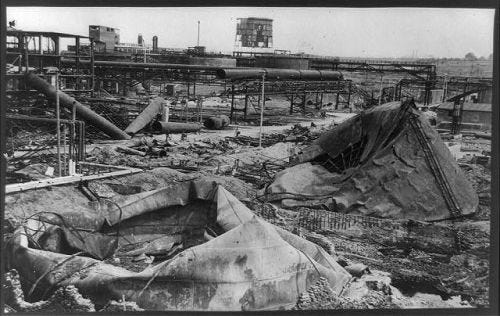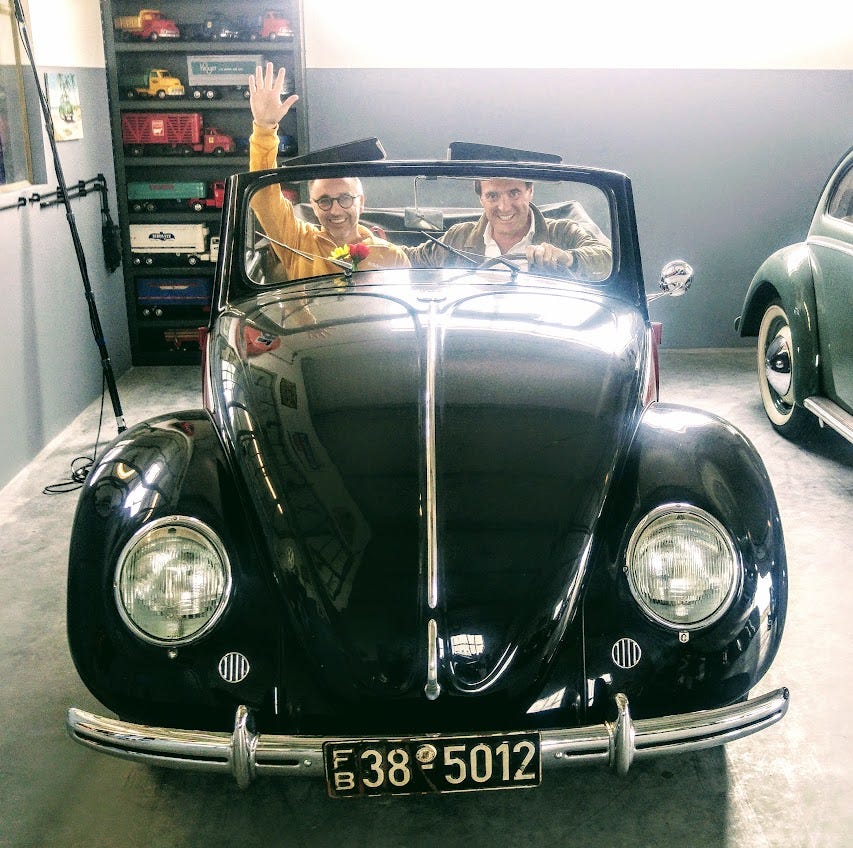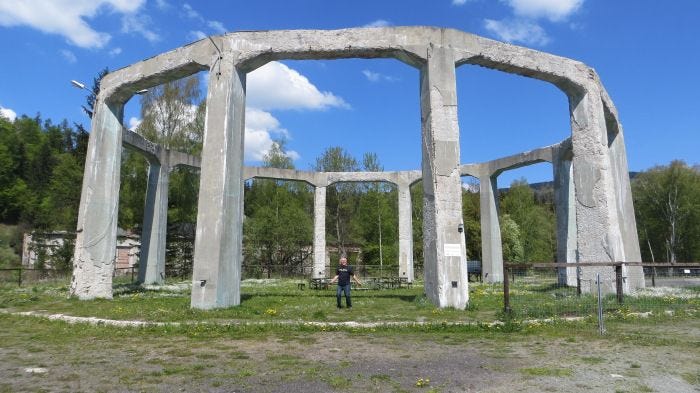Eleven things the Nazis did – and really didn't – invent
From flying saucers to Sarin, I do my best to sift reality from the fantasy when it comes to establishing what those fiendish Nazis dreamed up...
A FEW DAYS ago, in response to a tiresome tweet that a display of Union Jacks was proof that the UK was becoming a fascist state, I tweeted that ‘Flags are no more fascist than motorways’. It was, I thought, an immensely clever and subtle way of indicating that just because something was invented or adopted by a fascist regime, that didn’t necessarily make it fascist.
Until then, like many, I had always thought that motorways were invented by the Germans, but several people pointed out that the Italians had got there first. I guess if I had really thought about it, and as someone who has regularly braved the autostrade, it’s obvious that it would have been the Italians.
Anyway, it got me thinking about what was actually invented in Germany during the Nazi period, and also some of the absolutely wacko things that the Nazis are said to have invented, but really did not. Here then, is a list of eleven – please feel very free to add your own in the comments section!
1. The Nazi ‘Flying Saucer’
ONE of the most enduring myths concerning Nazi inventiveness is that the regime managed to invent flying saucers. In 1950, an Italian professor reported that the Nazis had designed and studied ‘flying discs’ as early as 1942. This prompted a ‘confirmation’ from a German scientist that same month, in which he revealed that he had indeed designed a flying saucer, but that the plans and a model had been stolen after the war by Czech secret agents. According to those who believe in ‘Nazi UFOs’, several top Nazis fled to Antarctica after the war on a flying saucer which could travel at some 3,000 miles per hour.
As evidence, ufologists point to a mysterious construction (above) that can still be found in the Owl Mountains in south-west Poland, which consists of twelve 30-foot high concrete pillars arranged in a circle and supporting a concrete ring. Some maintain that this was a launch pad for the Nazi flying saucer. However, without a shred of historical evidence supporting claims of such a diabolical Nazi scheme, it must be regarded as nonsense.
2. ‘The Bell’
Perhaps the most mysterious Nazi invention was simply called ‘the Bell’, a device so secret that nobody today knows what it really was, or even whether it existed. Reputed to be an anti-gravity machine – or more outrageously still, a time machine – ‘The Bell’ was supposed to contain two rotating cylinders that contained a mysterious substance called Xerum 525 that glowed violet and emitted strong doses of radiation.
The machine was supposedly the brainchild of a sinister SS officer called Hans Kammler, who had headed the Nazis’ secret weapons programme and had helped to develop the V-2 rocket that terrorised Londoners. At the end of the war, Kammler disappeared, and rumours soon spread that he was working for an eastern bloc power or for the Americans. Because nobody knew whether he was alive or dead, Kammler was the perfect vehicle to attach to any rumours of Nazi secret weapons such as ‘the Bell’.
3. The 1500-tonne tank
Although ‘the Bell’ and the Nazi flying saucer seem absurd, the Nazis themselves did believe in equally unfeasible armaments. In 1942, plans were once drawn up for a super-heavy tank called a Landkreuzer, which was to have been 42 metres long, 7 metres high, weighing 1,500 tonnes and boasting a crew of one hundred men.
Armed with the largest artillery weapons that would have been made, the Landkreuzer could have fired shells some 25 miles against heavy fortifications. However, the monster tank’s very impracticality soon put a halt to the project, and in early 1943, Albert Speer, Hitler’s armaments minister, cancelled the tank.
4. The Supergun
Sometimes referred to as the V-3, the Nazis developed the world’s first ‘supergun’. Designed to bombard London with 300-pound shells from across the Channel, the site of V3 was constructed near Mimoyecques in the Pas-de-Calais region of northern France. Massive shafts were built to contain five V-3s, each of which was to be 150 metres long. Shells were to be propelled by a series of rocket boosters placed along the barrel, that would have dispatched the projectiles from the muzzle at just over 2000 miles per hour.

Thankfully for the people of London, the V-3 was never to go into operation, as it was stymied by the straining German war economy, Allied bombing raids and massive technical problems. The legacy of the ‘supergun’ has lived on, and famously, the trial of the directors of the British machine tools manufacturer, Matrix Churchill, in the early 1990s, revealed that Saddam Hussein may have been planning to build a supergun similar to the V3.
5. Death Rays
Despite so many setbacks, some Nazis did not give up in their scheme to build a ‘wonder weapon’. In his memoirs, Albert Speer recalled an example that was even more ambitious than the V-3. In April 1945, as the Third Reich was collapsing, Speer had a conversation with Dr Robert Ley, the head of the German Labour Front, who was convinced that the regime had managed to invent a ‘death ray’.
“I’ve studied the documentation,” Ley excitedly told Speer. “There’s no doubt about it. This will be the decisive weapon!” The minister was unconvinced, and mockingly appointed Ley as ‘Commissioner for Death Rays’. Ley was unaware of the irony and accepted his new role. Naturally, no ‘death ray’ was ever produced, and even Hitler was reported to have thought the idea a crackpot theory.
6. Sarin nerve gas
We have the Nazis to thank for the deadly nerve agent called Sarin, which is 500 times more toxic than cyanide. Although the substance was placed in artillery shells, the Nazis never used Sarin against the Allies because they incorrectly feared an even deadlier chemical counter-attack. Infamously, Sarin was used by the Iraqis during the Iran-Iraq war, and also by a lunatic cult in its attack on the Tokyo underground in 1995, which killed twelve, and injured over a thousand.
7. Thalidomide
Although they never used chemicals such as Sarin, we do have to thank the Nazis for a chemical that has been unintentionally used to chilling effect – Thalidomide. According to some recent research, the drug, which was administered to women with morning sickness and caused their babies to be born without arms and legs, was developed in Nazi Germany as a possible antidote to Sarin.
More disturbingly, the claim suggests that Thalidomide was created at laboratories in Auschwitz, where it was simply known as ‘Drug 4589’, and was possibly tested on humans. Although the evidence is somewhat opaque, the 1954 patent for the drug indicates that human guinea pigs had already been subjected to trials.
8. The ‘World Ice Theory’
Much of this bunkum about race was propagated by the head of the SS, Heinrich Himmler, whose ludicrous beliefs helped to steer Nazi scientists down their absurd and often murderous paths. Himmler’s most outlandish theory was that the universe was made out of ice, and that as the Nordic peoples came from icy lands, it was surely they who were the master race.
As well as the ‘World Ice Theory’, Himmler subscribed to all sorts of junk science, such as astrology and psychic mumbo-jumbo. He even believed in hunting for the Holy Grail, which means that the third part of the Indiana Jones is not the outright fantasy that Steven Spielberg intended.
9. Liquid Coal
Not all the Nazis’ beliefs and inventions were complete nonsense. When the war started to turn against them, the Nazis soon found that they no longer had access to the Soviet oil fields they had captured. Facing desperate fuel shortages, Himmler ordered work to be carried out on alternative sources of energy.
One of the most promising appeared to be liquid coal, a fuel synthesised by mixing coal with oxygen and steam at high temperatures and pressure to produce a gas. This gas was then combined with a catalyst that resulted in liquid fuel. Although the idea of such a fuel sounds absurd, amazingly the idea actually worked, and several vehicles were run using liquid coal. During their invasion of Germany, American troops even siphoned off the fuel from captured enemy vehicles, and found that it worked on their own tanks and Jeeps.

Recently, liquid coal has been seen as one Nazi invention that may have some application today. In South Africa, the fuel had often been used instead of petrol and diesel, which were in short supply because of sanctions. However, producing the fuel requires a lot of energy, and in turn creates huge carbon dioxide emissions.
10. The Olympic Torch Relay
One Nazi invention that has endured until recently is the Olympic torch relay. Although the Nazis did not invent the torch itself – it burned for the first time at the 9th Modern Olympics in Amsterdam in 1928 – they most certainly dreamed up the relay for the Berlin Games of 1936. The man behind it was Carl Diem, one of the Games’ organisers, who had the idea as he and his colleague, Theodor Lewald, were on a train to Greece in 1934. Diem envisaged the relay as good way of linking Berlin with the Games in Ancient Greece, a culture that their Führer has always so greatly admired.
Sadly, the first torch relay proved to be no less controversial than the one last year for the Beijing Games. As the torch – forged from the same Krupp steel that would be used to build Hitler’s panzers – made its way north, it became a magnet for Nazis and their sympathisers. In Vienna, for example, the riots were far greater than the ones seen in London, Paris and San Francisco when the torch made its way to the Beijing Olympics in 2008.
11. The Beetle
In 1933, Hitler ordered Ferdinand Porsche to develop a ‘people’s car’ which would be cheap, basic, and capable of seating a family of five. Partially financed by the regime, Porsche produced the now famous ‘Beetle’, although during the 1930s it bore the somewhat less charming name of the ‘Strength Through Joy Car’ or ‘KdF Wagen’.

Priced at the same level as a motorbike, it was intended for Germans citizens to buy the car through a Nazi-run savings scheme. However, the exigencies of war production meant that the Beetle was first used as a military vehicle. It was not until the reopening of the Volkswagen factory by the British Army after the war that Beetle as we know it began to be produced, and since then, some 21,500,000 have been built.









Revell literally make a 1:72 model of a Nazi flying saucer (Haunebu II) with an accompanying grey description: “The existence and feasibility of this striking model from the time of the Second World War cannot be proven historically. Allegedly work began on this spherical aircraft in 1934. Its propulsion and the neutralisation of centrifugal forces inside the aircraft was achieved employing Vril energy fields. Airworthy prototypes of the Haunebu II with speeds of up to 6000 km/h first flew in mid-1943 but did not finish the flight test phase due to the effects of war.”
This article has prompted significant random 5:30am googlings on my part. I love that concrete henge thing. The Sarin thing is pretty interesting. I knew about that and it's fascinating that they were so afraid of a worse response that they didn't use it even when they got desperate. It makes you think about what we read today: that Putin will use nuclear weapons in Ukraine if he gets desperate enough. I mean why didn't the Germans use Sarin towards the end? They had literally nothing to lose...